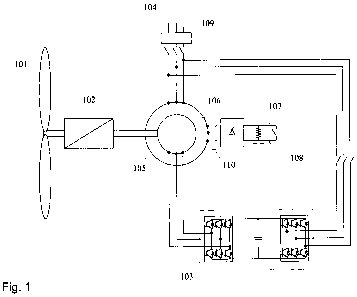Some of the information on this Web page has been provided by external sources. The Government of Canada is not responsible for the accuracy, reliability or currency of the information supplied by external sources. Users wishing to rely upon this information should consult directly with the source of the information. Content provided by external sources is not subject to official languages, privacy and accessibility requirements.
Any discrepancies in the text and image of the Claims and Abstract are due to differing posting times. Text of the Claims and Abstract are posted:
| (12) Patent Application: | (11) CA 2725531 |
|---|---|
| (54) English Title: | CONTROL METHOD AND SYSTEM FOR A WIND POWER INSTALLATION IN CASE OF GRID FAULTS |
| (54) French Title: | PROCEDE ET SYSTEME DE COMMANDE D'UNE INSTALLATION EOLIENNE EN CAS DE DEFAILLANCES DU RESEAU |
| Status: | Deemed Abandoned and Beyond the Period of Reinstatement - Pending Response to Notice of Disregarded Communication |
| (51) International Patent Classification (IPC): |
|
|---|---|
| (72) Inventors : |
|
| (73) Owners : |
|
| (71) Applicants : |
|
| (74) Agent: | MARKS & CLERK |
| (74) Associate agent: | |
| (45) Issued: | |
| (86) PCT Filing Date: | 2009-05-22 |
| (87) Open to Public Inspection: | 2009-11-26 |
| Availability of licence: | N/A |
| Dedicated to the Public: | N/A |
| (25) Language of filing: | English |
| Patent Cooperation Treaty (PCT): | Yes |
|---|---|
| (86) PCT Filing Number: | PCT/ES2009/070177 |
| (87) International Publication Number: | ES2009070177 |
| (85) National Entry: | 2010-11-23 |
| (30) Application Priority Data: | ||||||
|---|---|---|---|---|---|---|
|
The present invention relates to a method and system
for controlling a wind power installation connected to an
electrical power grid, in case of a fault in said grid.
In the electrical machines that form part of the
wind power installation, generators and transformers, it is
possible to change the impedance of the neutral closure
introducing a plurality of active and passive elements.
This limits the currents during the grid fault, thereby
reducing the peak torque in the mechanical train of the
wind turbines and allows guaranteeing compliance with the
network connection requirements, as control of the active
and reactive currents is maintained at all times.
La presente invención se refiere a un método y sistema para el control de una instalación eólica conectada a una red eléctrica, cuando se produce una falta en dicha red. En las máquinas eléctricas que forman parte de la instalación eólica, generadores y transformadores, es posible modificar la impedancia de cierre del neutro introduciendo una pluralidad de elementos activos y pasivos. De esta forma se limitan las intensidades circulantes durante el fallo de red con lo que se reduce el pico de par en el tren mecánico de los aerogeneradores y permite a su vez garantizar el cumplimiento de los requisitos de conexión a red, ya que se mantiene en todo momento el control de las corrientes activas y reactivas.
Note: Claims are shown in the official language in which they were submitted.
Note: Descriptions are shown in the official language in which they were submitted.

2024-08-01:As part of the Next Generation Patents (NGP) transition, the Canadian Patents Database (CPD) now contains a more detailed Event History, which replicates the Event Log of our new back-office solution.
Please note that "Inactive:" events refers to events no longer in use in our new back-office solution.
For a clearer understanding of the status of the application/patent presented on this page, the site Disclaimer , as well as the definitions for Patent , Event History , Maintenance Fee and Payment History should be consulted.
| Description | Date |
|---|---|
| Time Limit for Reversal Expired | 2013-05-22 |
| Application Not Reinstated by Deadline | 2013-05-22 |
| Deemed Abandoned - Failure to Respond to Maintenance Fee Notice | 2012-05-22 |
| Letter Sent | 2011-05-06 |
| Inactive: Correspondence - Transfer | 2011-04-12 |
| Inactive: Office letter | 2011-04-05 |
| Inactive: Single transfer | 2011-02-10 |
| Inactive: Cover page published | 2011-02-08 |
| Inactive: Notice - National entry - No RFE | 2011-01-20 |
| Inactive: IPC assigned | 2011-01-14 |
| Inactive: IPC assigned | 2011-01-14 |
| Inactive: First IPC assigned | 2011-01-14 |
| Application Received - PCT | 2011-01-14 |
| National Entry Requirements Determined Compliant | 2010-11-23 |
| Application Published (Open to Public Inspection) | 2009-11-26 |
| Abandonment Date | Reason | Reinstatement Date |
|---|---|---|
| 2012-05-22 |
The last payment was received on 2011-03-17
Note : If the full payment has not been received on or before the date indicated, a further fee may be required which may be one of the following
Patent fees are adjusted on the 1st of January every year. The amounts above are the current amounts if received by December 31 of the current year.
Please refer to the CIPO
Patent Fees
web page to see all current fee amounts.
| Fee Type | Anniversary Year | Due Date | Paid Date |
|---|---|---|---|
| Basic national fee - standard | 2010-11-23 | ||
| Registration of a document | 2011-02-10 | ||
| MF (application, 2nd anniv.) - standard | 02 | 2011-05-24 | 2011-03-17 |
Note: Records showing the ownership history in alphabetical order.
| Current Owners on Record |
|---|
| INGETEAM ENERGY, S.A. |
| Past Owners on Record |
|---|
| AINHOA CARCAR MAYOR |
| DAVID SOLE LOPEZ |
| JESUS LOPEZ TABERNA |
| JESUS MAYOR LUSARRETA |
| JORGE ACEDO SANCHEZ |
| JOSU ELORRIAGA LLANOS |
| LUIS MARROYO PALOMO |
| MIKEL ZABALETA MAEZTU |
| SUSANA SIMON SEGURA |